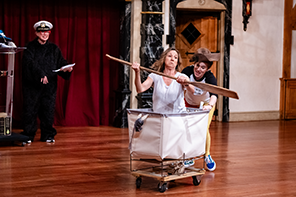The Complete Works of William Shakespeare
(Abridged) [Revised] (Again)
Completing Shakespeare’s
Complete Works At Last (Again)
By Adam Long, Daniel Singer, and Jess Winfield (new revisions by Daniel Singer and Jess Winfield)
American Shakespeare Center, Blackfriars Playhouse, Staunton, Virginia
Saturday, June 22, 2024, C–5 (stalls, center); H–1 (stalls, left)
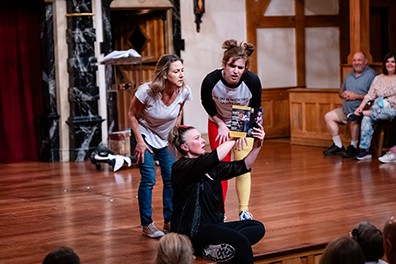
Jenny Bennett, sitting, shows the play program's list of William Shakespeare's complete works to Ginna Hoben, left, and Allie Babich in the American Shakespeare Center's production of The Complete Works of William Shakespeare (Abridged) [Revised] (Again) at the Blackfriars Playhouse in Staunton, Virginia. Photo by October Grace Media.
You’ve not seen all of Shakespeare until you’ve seen the Complete Works of William Shakespeare. That’s a rule I’ve derived from the times I mention seeing a Shakespeare play and oh-so-subtly brag that I've seen all 42 plays connected to Shakespeare’s pen. The reply I inevitably get is, “Have you seen The Complete Works of William Shakespeare (Abridged)?” referring to the winking, satirical spin on the Bard’s works by Adam Long, Daniel Singer, and Jess Winfield of the Reduced Shakespeare Company.
Hitherto, I have not. It’s not that I’ve been avoiding the show; it’s been avoiding me, as if frightened of my pen (or my keyboard). I saw the world premiere of the Reduced Shakespeare Company’s William Shakespeare's Long Lost First Play (abridged) at the Folgers in 2016 and knew by reputation that their company-launching Complete Works deserved its long-enduring popularity. However, wherever I’ve gone Shakespeareancing, Complete Works in one or other of its forms—the 1987 original was [Revised] in 2007 and (Again) in 2022—would be on the playbill before or after my visits. The one time I got it on my schedule was when my son, Jonathan, was stage manager for a Hudson Warehouse production at Riverside Park in New York. A thunderstorm canceled that night’s show.
Well, I’ve finally seen it, the Again version, at the American Shakespeare Center’s Blackfriars Playhouse in Staunton, Virginia, a venue perfect for such a semi-improvisational, audience-participation show. Furthermore, the cast comprised three of my favorite Shakespeareans: actor and playwright Ginna Hoben, actor and director Jenny Bennett, and actor and musician Allie Babich. Indeed, the casting more than the play convinced me to squeeze in a day’s trek down to Staunton to see this production twice: I did the matinee and evening performances to make sure I captured all the jokes. Well, most of them, at least.
I came away both times breathless from laughing so much and shouting “Get thee to a nunnery!” I came away with some of Hoben’s vomit, too, which has joined our Shakespearean props collection along with confetti, torn pieces of love notes, red and white roses, and Macbeth’s throne that Patrick Page stabbed into near oblivion seeing a delusion of Banquo sitting on it. Back to the vomit: The acting schtick of Hoben’s character is wearing wigs and throwing up on audience members. Only pretend, mind you, until her climactic scene as Ophelia in which she used clay string to represent the puke she splays across the three front rows.
Maybe I shouldn’t be writing a theater review—I’m sorry, a Shakespeareances “analysis”—laced with gross bodily expulsions. It’s the mood I’m in after seeing Babich, Bennett, and Hoben play Long’s, Singer’s, and Winfield’s newest script. It’s all pure silliness appropriate for most ages and all categories of Shakespeare lovers and haters.
It’s also the particular theatrical skills the three women bring to the three men’s lines in this playhouse they know so well from playing and directing here. These skills include mastery of Shakespeare’s language and improvisational pointers; singing and playing piano, including a Schroeder-size “grand piano”; performing clown and commedia dell’arte; and managing audience interaction and audience non-interaction, as necessary. On the last I’m thinking about a bozo behind me in the matinee who shouted that Babich’s socks didn’t match. Babich’s only response was to look down at her ankles while her mates carried on with subsequent lines. Why her socks didn’t match would be revealed later, hence my choice of the descriptor bozo for the loudmouth behind me (you’ll soon appreciate my nesting metaphor talents exhibited here, I hope).
First, a quick refresher on the American Shakespeare Center’s Blackfriars Playhouse. It is the world’s only re-creation of Shakespeare’s indoor London theater, all warm wood and intimacy, the audience in close proximity on all sides, including sitting on “gallant stools” on each side of the stage. The American Shakespeare Center’s original production practices for this original production-authentic space include no amplification, no electronic or digital special effects, and the lights stay on. That last becomes a running joke as the actors would instruct the stage manager, Robert “Bob” Greene, to bring the lights up, and he’d shout back exasperatedly from his perch up in the balcony, “They’re on!” Another tradition is no fourth wall—or any wall, really, except the tiring house at the back of the stage. Thus, the action on stage spills into the audience, and vice versa. In this production, actors play audience members and audience members play actors plus a couple of goalposts and an id.
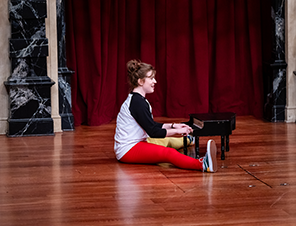
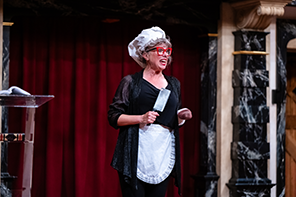
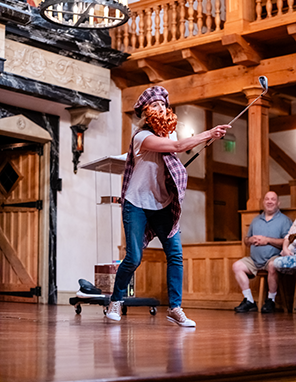
From the top: Allie Babich plays all by herself; Jenny Bennett stars as Chef Titus, the Decapitating Gourmet; The bearded Ginna Hoben plays Macbeth or a fellow Scott striking a wedge from the nave to the chops. Photos by October Grace Media.
The set for this production is, as Blackfriars is wont to do, a bare stage; at the start, only a glass podium on a rolling platform occupies it. A volume of Shakespeare’s Complete Works, cover forward, sits on the middle shelf, and five other versions are lined up on a bottom shelf. A small boombox rests on top. Enter Babich, with her red sock and yellow sock between the hem of her denim coveralls and blue tennis shoes and wearing a t-shirt bearing “We do it with the lights on” (the American Shakespeare Center’s slogan). She takes up the Complete Works and shows it to the audience, up close for those who have never before encountered “a book.” And not just any book: “It’s better than the Bible,” she says. “The plots make more sense, and there’s more lines for women.”
Babich introduces Bennett as an eminent Shakespeare scholar. “Pre-eminent Shakespeare scholar,” Bennett corrects her. Bennett, dressed in black pants, black sheer jacket, and black tennis shoes but red-frame glasses, will endure many elaborate Elizabethan costume changes and resulting bizarre stage business throughout her performance. She follows up on Babich’s biblical reference by proclaiming that Shakespeare’s Complete Works should be placed in every hotel room in America. “Shakespeare is hot!” she proclaims.
Bennett seeks similar fans in the audience and comes upon one who initially seems smart but really isn’t. Turns out she’s not an audience member but a self-described “really convincing actor.” This is Hoben, a silly, petulant ingenue in this production but a veteran at playing one-woman shows, evident in her self-aware, audience-interactive instincts. While I could unleash a plurality of kudos for this threesome’s comic physicality and impeccable timing, it’s Hoben who lands the most stunning moment of the show when she slips into Hamlet’s “What a piece of work is a man” speech and flips the house’s mood upside down. As the audience awaits a punchline, Hoben delivers a true reading of the speech’s pathos and urgency in Hamlet’s assessment that man may be “the beauty of the world, the paragon of animals—and yet to me, what is this quintessence of dust? Man delights not me.” The audience remains in mesmerized silence multiple seconds before erupting in applause for Hoben’s quintessential Shakespearean performance.
The three actors embark on setting a record for performing Shakespeare’s Complete Works in 97 minutes. Yeah, they presumably accomplish this every show, but it’s still an amazing feat of frantic energy. The show opens with Romeo and Juliet (this product originated as a short-skit condensation of that tragedy that later expanded into what would become a condensation of the Complete Works). Babich and Hoben use commedia conventions—hence, Babich revealing she’s not wearing different color socks but red and yellow tights as part of her clowning costume—to play the two lovers plus other characters while Bennett takes the role of a directorial Chorus.
Reality and play-acting blur lines. On playing Juliet, Hoben says, “I’m told I look young on stage.” This is true. When she must go up to the balcony, however, she protests, “I’m not climbing up the stairs. I’m too old for that. I’m almost 50.” Also true, on evidence of one of her autobiographical plays. “You are 13,” Bennett retorts, the director insisting the actor get into character. “Go up to your room!” Lines are deliberately mangled, per the script. “What’s in a name, anyway?” Juliet (almost) famously says. “That which we call a nose by any other name would still smell.” Metaphors are flattened and the script gives way to the players' imaginations. “Gallop apace, you fiery-footed steeds,” Hoben’s bewigged Juliet says. The script directs her to ride an “imaginary horse”; Hoben chooses to paddle across the stage in an inflatable pony raft. Juliet at one point calls Romeo a “churl,” and Hoben switches from grief-stricken character to admiring actor. “Churl! That’s a word from Shakespeare we should bring back.”
After completing the abridged Romeo and Juliet, the cast does the math and realizes completing the Complete Works will take seven hours at that pace. Despite Hoben’s advice that they give up the endeavor, the three tackle the rest of the Canon by virtue of three bothersome trends in modern Shakespeare productions.
1. Ultracompilations.
- All of the histories, including King Lear, are presented as an American football game, thus the need for extras playing goalposts. The skit skewers the plays’ historical and chronological sequences and even Shakespeare’s tetralogical sequence as King John runs amok through the Henriads, including “cutting Henry the Sixth into three parts.”
- All of the comedies are lumped into one mash-up script. After all, they are all misogynistic, racist, and xenophobic. “Who better to lead the discussions than three white women?” Bennet says. “And I’m queer.” This segment has absolutely no reason and little rhyme, but a great running joke as the “convenient Judeo Italian Stereotype” shows up in various plots of the Woke-reimagined plays. Even Bottom—who may have an ass’s head but, Babich brags, “I have the ass of a man and I’m hung like a donkey!”—ends up coupled with the Clueless Young Soldier, who is sick with love and gender dysphoria. “Thereby hangs a sweet tail."
2. Ultrathematic settings
- Titus Andronicus is set as a cooking show. “When you have a crappy day—your hand is cut off, your sons murdered, your daughter raped and her tongue cut out and hands cut off—the last thing you want to do is cook,” an upbeat Bennet as Titus says as the bewigged and stump-armed Hoben’s Lavinia assists. Bennet goes on to demonstrate how to decapitate a person using Babich as her meat of choice: “You cut from the carotid artery to the jugular vein” and serve “this hateful vigor with a little bit of butter.” When Bennett calls “Hark, villain,” her mates reply, “Yes, Chef!”
- Macbeth is ancient Scots playing golf and speaking impregnable Scottish accents that make it impossible to translate here.
3. Ultracut scripts.
- Julius Caeasar is reduced to just the assassination. And why not? That's the only scene in Shakespeare's play that his participating characters contend will be "acted over in states unborn and accents yet unknown"—such as the Scottish accents Bennett and Hoben used a few minutes earlier.
- Othello comprises the title’s character’s final speech, borrowing from another tragedy: “Speak of me as I am; let nothing extenuate of one who loved not wisely, but too well. For never was there a story of more woe, than this of Othello and his Desdemono.”
Another trend haunting the horizon of American theater is financial resources. The play represents this by its take on the outlier of Shakespeare’s Canon, The Two Noble Kinsmen, which Hoben misrepresents as the T-Mobile Kinsmen. In her version, the title characters in love with the same woman need to be on the Simple Choice Family Plan. Hoben assures her colleagues that she doesn’t have a product placement deal with the cell phone company: “They just gave me money to mention them and my phone,” she says.
The cast gets through the entire canon before the intermission, but as they count through the list in the play program they’ve borrowed from an audience member, they discover they forgot Hamlet. Hoben decides to abandon the project and runs off with Bennett chasing after her, a bewildering sequence proving to be the script’s only faltering moment that ends the first half and starts the second half. But it does give us a redeeming moment in leaving Babich alone on the stage putting her musical talents on full display playing a toy piano and singing Eric Carmen’s “All By Myself.”
That leaves us with Hamlet filling the production’s second half. But first, they cover the sonnets by giving a card of opening lines to a patron in the front row to be passed through the audience. The audience obliges, dutifully passing the card along the rows and back through the theater and, we hope, up to the balcony.
The jokes imposed on Hamlet include
- Visual puns: the foils Hamlet and Laertes use for their duel are boxes of Reynolds Wrap.
- Cultural references: Claudius is anti-Woke, turning “The lady doth protest too much” into meaning “she was asking for it, right?”; dismissing “a certain woman’s movement” as “Oh, MeToo, boo-hoo!”; and determining Hamlet’s mousetrap play is “fake news.”
- Contextual jokes: Hoben, learning that Ophelia dies off stage, will have her way anyway and dies dramatically on stage.
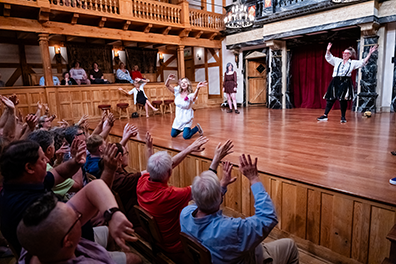
Ginna Hoben, kneeling at the front of the stage, and Jenny Bennet, standing at the back, lead the audience in playing the Super Ego of Ophelia (standing at the back corner of the stage) in the American Shakespeare Center's production of The Complete Works of William Shakespere (Abridged) [Revised] [Again]. Photo by October Grace Media.
However, it is Hamlet’s railing at Ophelia to “Get thee to a nunnery” that weaves all the elements of this production—the whimsical script, the Blackfriars environment, the three performers, the audience, and the culture we currently live in—into one unforgettably mighty theatrical force. Trying to expound on the socio-gender dynamics of Hamlet, using "assaultive language," telling Ophelia to get herself to a nunnery, the players select a woman from the audience to play Ophelia. She screams at the end of Hamlet’s delivery, but the players want a more multilayered effect. So, they assign a kid from the audience to be Ophelia’s id, running back and forth across the stage. Wanting more depth, the actors tab the rest of the audience to play Ophelia’s super ego. We in in the first two rows must wave our hands back and forth and shout “Get thee to a nunnery.” First rehearsal, we are neither super nor very egotistical, so we do it again and get a pass grade. Section B behind us is charged with shouting “Paint an inch thick,” and they pass their initial rehearsal. Section C, the back of the stalls and the balcony, must shout “Screw you! Screw Polonius! And Screw the Danish Patriarchy.” Naturally, they rock their rehearsal.
Then we all do it together, the guest Ophelia letting out a scream that would shake the bones of Old Hamlet, the kid sprinting back and forth across the stage before nearly collapsing, me and my fellow non-actors pushing our vocal chords and rotator cuffs to the limit, and the “Screw you!” screams dominating the auralscape.
But this is only the nunnery scene. We still have the Mousetrap, the killing of Polonius, the drowning of Ophelia on stage, and the fight with foils to rush through. Not nearly fast enough to suit Babich, Bennett, and Hoben, who decide to set the all-time world record for playing Hamlet, and perform it all again at breakneck speed twice, and twice breaking the record.
Then they do it backward, and you get the rare treat of watching Babich’s Polonius undying on stage. For his death, she slides her head to the floor between the tiring house curtains, moaning all the way down; for his undeath, she reverses the direction of her head and the moan’s modulation. I’ve never seen, or heard, anything like it in 50 years of Shakespeareancing.
And having seen it and this production, I endorse the rule: you ain’t seen all of Shakespeare until you’ve seen the Complete Works of William Shakespeare (Abridged) and/or [Revised] and/or [Again].
Eric Minton
October 14, 2024
Comment: e-mail editorial@shakespeareances.com
Start a discussion in the Bardroom




 Find additional Shakespeareances
Find additional Shakespeareances